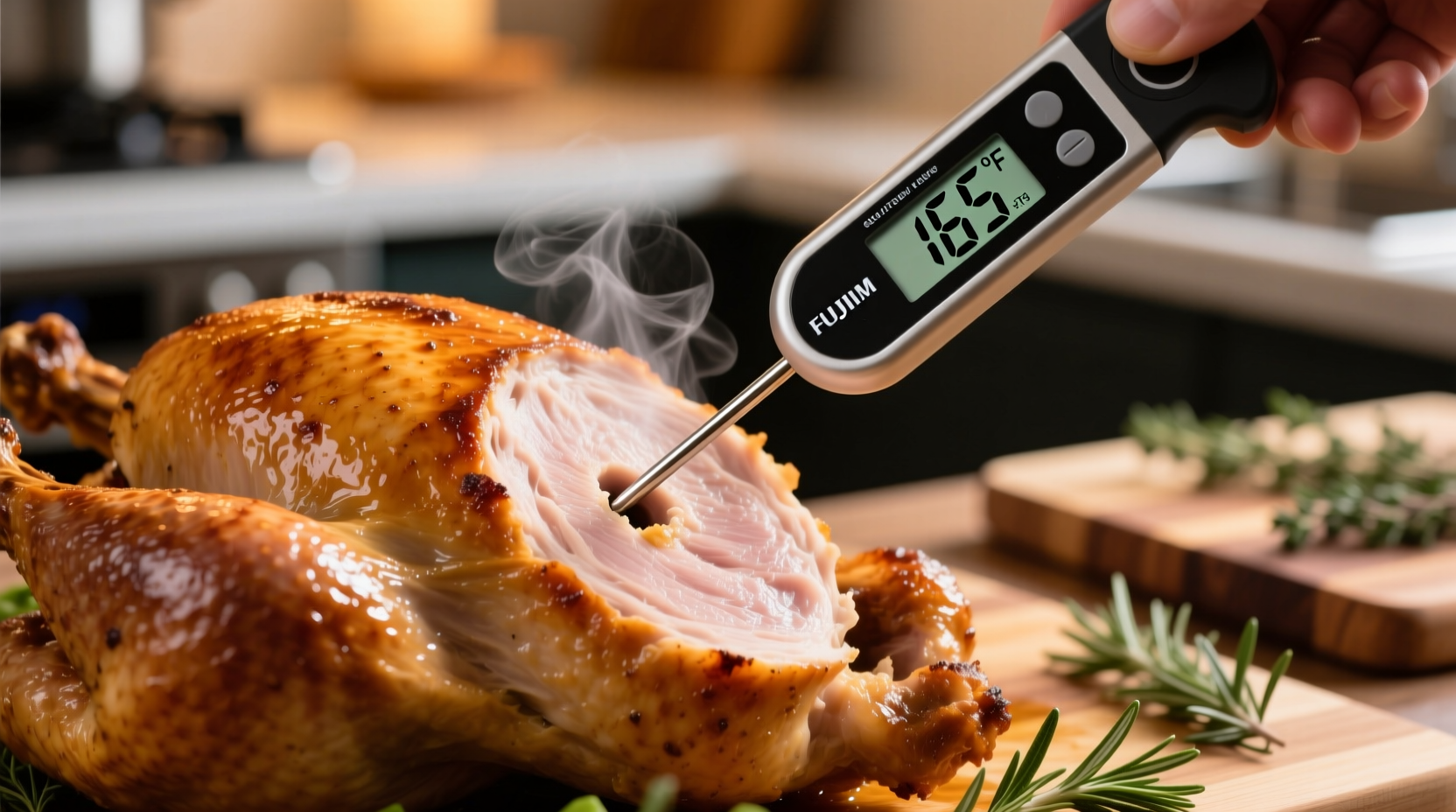The only reliable way to know if turkey is fully cooked is by measuring its internal temperature with a food thermometer. The USDA recommends cooking turkey to a minimum internal temperature of 165°F (74°C) in the thickest parts of the breast, thigh, and wing. This precise temperature ensures harmful bacteria like Salmonella and Campylobacter are destroyed while maintaining optimal texture and moisture.
When you're standing in your kitchen with a roasting turkey, time matters and guesswork isn't safe. Getting this right protects your family from foodborne illness while delivering perfectly juicy results. Forget unreliable methods like checking juice color or leg wiggle tests—modern food safety standards require precise temperature verification. This guide walks you through exactly what to do at each stage of cooking, with professional techniques you can trust.
Why Temperature Matters More Than Tradition
For generations, cooks relied on visual cues to determine turkey doneness. Today, food science shows these methods carry significant risks. The USDA Food Safety and Inspection Service confirms that color and texture alone cannot guarantee safety. Undercooked turkey remains the leading cause of Thanksgiving food poisoning outbreaks, according to CDC data.

Your Step-by-Step Turkey Doneness Verification System
Pre-Cooking Preparation: Setting Up for Success
Before your turkey hits the oven, proper thermometer selection makes all the difference. Digital instant-read thermometers provide accuracy within ±0.5°F, while leave-in probe thermometers with wireless alerts prevent constant oven opening. Calibrate your thermometer using the ice water method (should read 32°F/0°C) or boiling water test (212°F/100°C at sea level).
During Cooking: Strategic Temperature Monitoring
Monitor progress without compromising oven temperature:
- Insert thermometer probe horizontally into the thickest part of the breast, avoiding bone
- Check inner thigh temperature where it meets the body, again avoiding bone contact
- Verify wing joint temperature for comprehensive safety coverage
- Take readings in multiple locations as turkey approaches target temperature
| Body Part | Target Temperature | Minimum Safe Temperature | Texture Indicator |
|---|---|---|---|
| Breast | 160-162°F (71-72°C) | 165°F (74°C) | Firm but yielding to touch |
| Thigh | 165-170°F (74-77°C) | 165°F (74°C) | Juices run clear, no pink tinge |
| Wing Joint | 165°F (74°C) | 165°F (74°C) | Meat separates easily from bone |
Final Verification: The Critical 165°F Threshold
When your thermometer reads 160-162°F in the breast, remove turkey from the oven. Carryover cooking will raise the temperature 5-7 degrees during resting. The FDA Food Code specifies that 165°F must be reached in all parts of the turkey because:
- Pathogens are destroyed in 16.7 seconds at 160°F but instantly at 165°F
- Temperature varies significantly within different parts of the bird
- Resting time allows heat to equalize throughout the meat
Context Boundaries: When Visual Cues Fail
Understanding the limitations of traditional doneness indicators prevents dangerous assumptions:
- Juice color: Pink juices can appear in properly cooked turkey due to myoglobin reaction, especially in younger birds
- Leg movement: Legs may wiggle freely before reaching safe temperatures in large turkeys
- Skin color: Deep golden brown skin develops well before internal safety is achieved
- Meat texture: Breast meat feels firm at 150°F—below the safe threshold
Resting Period: The Hidden Safety Phase
After reaching target temperature, allow 20-40 minutes of resting time:
- Smaller turkeys (under 12 lbs): 20 minutes minimum
- Standard turkeys (12-16 lbs): 30 minutes ideal
- Large turkeys (over 16 lbs): 40 minutes recommended
During this critical phase, residual heat continues killing pathogens while moisture redistributes. The National Turkey Federation confirms that resting time completes the cooking process safely.
Avoiding Common Temperature Verification Mistakes
Even experienced cooks make these critical errors:
- Checking only one location instead of multiple critical points
- Touching bone with thermometer probe (gives falsely high reading)
- Not waiting for thermometer stabilization (instant-read needs 3-5 seconds)
- Opening oven too frequently (adds 15-20 minutes to total cooking time)
Special Considerations for Different Cooking Methods
Each preparation technique requires specific verification approaches:
- Brined turkeys: May appear done visually before reaching safe temperatures
- Smoked turkeys: Low-and-slow cooking requires extra attention to final temperature
- Deep-fried turkeys: Check internal temperature immediately after removal from oil
- Stuffed turkeys: Verify both turkey and stuffing reach 165°F separately
When in Doubt, Measure Again
If you're uncertain about doneness, take additional readings rather than risk serving undercooked poultry. Foodborne illness from turkey typically manifests 12-72 hours after consumption, making immediate verification essential. Remember that properly cooked turkey continues cooking during resting—removing it at 160-162°F in the breast ensures perfect results without overcooking.
Can turkey be safe at 160 degrees Fahrenheit?
Turkey breast can be removed from heat at 160-162°F because carryover cooking will raise the temperature to the safe 165°F threshold during resting. However, the final safe temperature must reach 165°F throughout the bird before consumption.
Why does my turkey thermometer show different temperatures in different spots?
Temperature variations occur because heat distributes unevenly in large birds. Always check multiple locations—the breast, thigh, and wing joint—as these areas cook at different rates. The safest practice requires all areas to reach 165°F.
Do I need to check the stuffing temperature separately?
Yes, always verify stuffing temperature separately. Even if the turkey reaches 165°F, stuffing may remain below safe temperatures. Insert thermometer into center of stuffing mass to confirm it reaches 165°F independently.
How long should turkey rest before carving?
Rest turkey for 20 minutes per 10 pounds of weight. A 12-16 pound turkey needs 25-30 minutes minimum. This allows juices to redistribute and final cooking to complete, ensuring both safety and optimal texture.











 浙公网安备
33010002000092号
浙公网安备
33010002000092号 浙B2-20120091-4
浙B2-20120091-4